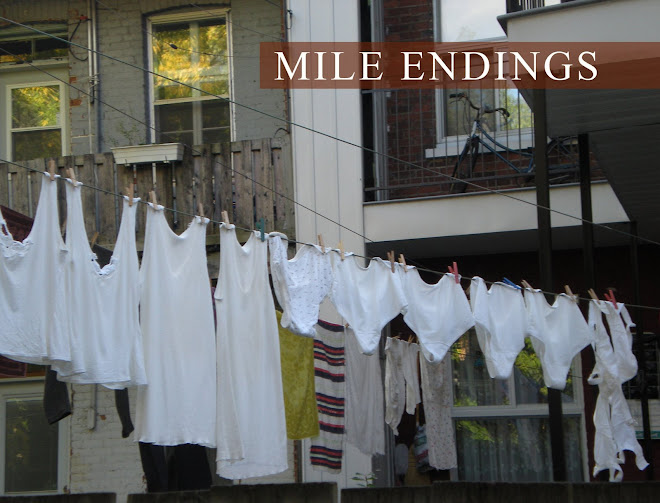
At the north edge of Mile End a web of footpaths leads to the railroad tracks.
If you follow the paths to the chain link fence there's a hole, and if you step through that, you end up someplace else.
It’s quiet and the air smells sweet. Pink blossomed milkweed plants and a tangle of purple wildflowers mix with Queen Anne’s lace along the tracks that stretch into the distance.
It's a big, wide-open space –the opposite of an underpass. This is the scenic route to the other side of the tracks.
I used to haul my bike over the tracks all the time. I admired the way gaps in the fence always opened up, no matter how many times Canadian Pacific mended them to keep people out.
Then I heard about people getting tickets.
I sit down on a bench in the sculpture garden north of Van Horne, not far from the hole in the fence.

I meet a friendly dog, Kismo, and his owner Vito, who says he stopped crossing the railway when he heard about the ticketing. Then Vinnie and his young daughter Gabrielle wander by, but steer clear of the railroad. Vinnie got a warning from the CP police about crossing the tracks and says that’s enough to keep him out.
Mary was walking her dog Maggie across the tracks when the CP police stopped her. They said it was illegal, and that she could get killed.
"They did this whole what-if thing," she says. "'What if you tripped and hit your head, and a train comes. Then they gave me a ticket for $140."
Somehow, despite the ticket, she can’t stay away.
"It's a great walk, away from the sidewalk and I love the solidarity with other people who walk there. It's a little anarchist."

Some of the anarchist walkers are organizing. A group of citizens recently papered a section of the fence with signs that say: "Open/Ouvert." And now there's a petition demanding an end to ticketing and safe level crossings at the tracks (http://www.petitiononline.com/ouvert02/petition.html).


As I walk alongside the tracks, I don't run into any CP police, although I do see their signs. Danger. Private Property. No Trespassing.
There's not a lot of traffic on this line now, maybe a couple freight trains a day. I don't see any during my walk but I find a pigeon sliced in two by an earlier train. A reminder: if you’re going to be here you better watch out.

The sculptor Glen Lemesurier has a workshop that backs onto the tracks and he nods when I point out the bird. "They fall asleep in the sun on the warm tracks and don't wake up when the train comes," he says.
"Off the tracks, off Augie," Glen tells his son as they walk along the track with Bonnie Prince Billy, a husky-chow mix who's as energetic as his owner. "I don't want you ever to get in the habit of walking on them."
Augie is 10 and his dad has been working in his rail-side studio since before he was born. Augie has already spent years train spotting with his father's binoculars.
For his part, Glen seems to have reached an understanding with his neighbours at CP. He advises people to watch for the railroad cops and to not cross if they see them. But since he's not one to keep a low profile, his personal method of dealing with the rail authorities is based on a love of trains.

"The chef du chemin is pretty cool," he says. "I used to go down to the Outremont rail yards before they closed to get parts from old engines, brake pieces, nuts, bolts. I did 30 sculptures made from train parts."
Some of these are on display in his sculpture garden near the tracks, a Mile End landmark at Van Horne and Clark.

"The engineers used to stop the train and come into my workshop for a break," Glen says. "I'd talk to the switcher when there was one here. He was great, he gave me a lot of parts."
Striding through the tall grass along the tracks, he moves past the trees he's planted in the past few years. Forget about private property, he's a proud gardener as he points out willow, aspen, chestnut, sumac, white pine, poplar, pear, hemlock and cedar trees.

"In 10 or 15 years it'll be a forest," he says, picking a strawberry growing in the grass and popping it in his mouth.
His tree planting along the tracks makes me think of the parks some cities have made on old railway lines, like la Promenade Plantée in Paris or the High Line in Manhattan. But Glen's not waiting for the trains to stop running.
I sit on the bench in the sculpture garden in the shade of some poplars. A train thunders by with a long rumble. After that there's just the whoosh of traffic from the underpass and the sound of the breeze in the leaves.
Then, with a rustle, a person pops out of the hole in the fence, like a deer, or a rabbit. A few minutes later someone else comes through. They startle when they see me, but I'm not giving out any tickets, so they take the path by the sculptures made from the gears and rods and bits of old trains and continue on their way.




